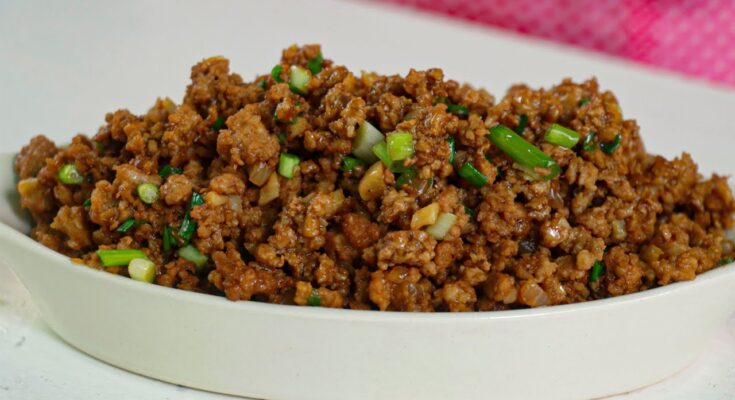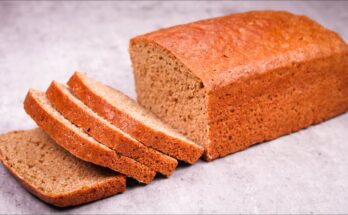Ground Pork Recipe: Cooking with ground pork is one of the easiest and most delicious ways to prepare a hearty meal for the family. Whether you’re a beginner in the kitchen or an experienced cook, ground pork gives you endless options to experiment with. From stir-fries to pasta, dumplings, meatballs, or even as a topping for rice, ground pork brings out flavors that are savory, rich, and deeply satisfying.
In this step-by-step guide, you’ll learn not only how to cook ground pork perfectly but also what ingredients to use, how to season it properly, and creative ways to serve it. By the end, you’ll be confident enough to whip up your own flavorful ground pork dishes at home.
Introduction to Ground Pork Recipes
Why Ground Pork is a Versatile Ingredient
Ground pork is one of those ingredients that easily adapts to various cuisines. Unlike beef, which can sometimes be heavy, or chicken, which may lack richness, pork balances tenderness with deep flavor. It absorbs spices beautifully, making it perfect for Asian stir-fries, Mexican tacos, Italian pasta sauces, or classic American meatballs.
The versatility also comes from the fat content. Ground pork typically has more fat than ground chicken or turkey, which means it cooks juicier and delivers a more satisfying bite. Whether you’re pan-frying, baking, or simmering it in sauce, ground pork retains flavor without drying out too quickly.
Benefits of Cooking with Ground Pork
- Affordable: Ground pork is usually cheaper than beef, making it budget-friendly.
- Quick to cook: Unlike larger cuts of meat, ground pork cooks fast, making it ideal for weeknight meals.
- High in protein: A great source of protein for energy and muscle repair.
- Flavorful: The natural richness means you can season lightly and still enjoy deep flavors.
If you’ve been stuck cooking the same chicken or beef recipes, ground pork might just be the ingredient that refreshes your kitchen routine.
Ingredients You’ll Need
Before jumping into the cooking process, let’s look at the ingredients required. While the recipe can be customized to your taste, here’s a classic list for a basic ground pork dish.
Essential Ingredients for Flavor
- Ground pork (1 lb / 450g): The star of the dish. Choose fresh pork with a bit of fat for juiciness.
- Garlic (2–3 cloves, minced): Adds a rich, aromatic base.
- Onion (1 medium, chopped): Provides sweetness and depth.
- Soy sauce (2 tbsp): For umami flavor.
- Salt & pepper (to taste): Basic seasoning.
- Oil (2 tbsp): For frying (vegetable, sesame, or olive oil).
Optional Add-ons to Enhance Taste
- Ginger (1 tsp, grated): For a spicy kick.
- Chili flakes or fresh chili: Adds heat for spice lovers.
- Bell peppers, carrots, or peas: Extra nutrition and color.
- Oyster sauce or fish sauce: Deepens the savory flavor.
- Fresh herbs (cilantro, parsley, or green onions): For freshness at the end.
Tips for Choosing Fresh Ground Pork
- Look for a pinkish-red color—avoid gray or dull-looking meat.
- Check the fat ratio—around 20% fat makes the pork flavorful without being greasy.
- Buy from a trusted butcher or store to ensure quality.
- Always smell the pork before cooking—fresh pork should not have a strong odor.
Having the right ingredients makes cooking smooth and ensures the dish turns out flavorful every time.
Kitchen Tools You’ll Need
Must-Have Cooking Utensils
To make cooking efficient, gather these tools before starting:
- Non-stick skillet or wok: For frying the pork evenly.
- Cutting board & sharp knife: To chop onions, garlic, and vegetables.
- Mixing spoon or spatula: To stir and break apart the pork while cooking.
- Measuring spoons & cups: To keep seasoning balanced.
Helpful Kitchen Gadgets
While not mandatory, these gadgets make cooking easier:
- Garlic press: Speeds up mincing garlic.
- Food processor: Useful if you’re making ground pork from scratch.
- Digital thermometer: Ensures the pork reaches a safe cooking temperature (160°F / 71°C).
By organizing your tools and ingredients beforehand, you’ll save time and avoid kitchen stress.
Step-by-Step Guide to Cooking Ground Pork
Cooking ground pork is simple, but doing it the right way ensures maximum flavor and the perfect texture.
Step 1 – Preparing the Ingredients
Start by washing and chopping your vegetables. Mince the garlic and onion finely so they melt into the pork while cooking. If you’re adding ginger, chili, or bell peppers, cut them into small pieces too.
Pat the ground pork dry with a paper towel to remove excess moisture—this prevents steaming and helps achieve a nice sear when frying.
Step 2 – Seasoning the Ground Pork
Before adding pork to the pan, season it lightly with salt, pepper, and a splash of soy sauce. This step infuses flavor right from the start. If you prefer, you can also marinate the pork for 15 minutes with soy sauce, garlic, and ginger for extra depth.
Step 3 – Cooking the Pork to Perfection
Heat a skillet or wok over medium-high heat, add oil, and once hot, toss in the garlic and onions. Sauté until fragrant, then add the ground pork. Break it apart using a spatula, spreading it evenly across the pan.
Let it cook undisturbed for 2–3 minutes to develop a golden-brown crust, then stir occasionally until the pork is fully cooked through. The meat should no longer be pink.
Step 4 – Adding Vegetables and Spices
Once the pork is nearly cooked, add vegetables and any additional seasonings like chili flakes or oyster sauce. Stir everything together, letting the vegetables soften while absorbing the pork’s flavor.
Step 5 – Final Touches and Garnishing
Turn off the heat and sprinkle fresh herbs like green onions or cilantro. These add color and brightness to the dish. Serve hot with rice, noodles, or bread depending on your preference.
Cooking ground pork is truly that easy—within 20 minutes, you’ll have a hearty, flavorful meal ready to serve.
Serving Suggestions
Now that you have a perfectly cooked ground pork dish, the next step is figuring out how to serve it. The beauty of ground pork is that it pairs well with just about anything, from rice to noodles, bread, and even as a filling for wraps.
Pairing Ground Pork with Rice
Rice and ground pork are a match made in heaven. A bowl of steaming hot rice topped with savory ground pork creates a comforting and filling meal. You can drizzle some soy sauce or chili oil on top for extra flavor. For a healthier twist, you can serve it with brown rice or even cauliflower rice if you’re cutting carbs.
If you’re meal-prepping, make a large batch of ground pork stir-fry and portion it out with rice into containers. It reheats beautifully, making it a practical lunch option for busy days.
Using Ground Pork in Noodles and Pasta
Ground pork works just as well with noodles and pasta. For an Asian-inspired dish, toss ground pork with soy sauce, sesame oil, and stir-fried vegetables over egg noodles or rice noodles. If you’re craving Italian flavors, mix ground pork into a tomato-based sauce and serve it over spaghetti—it’s a delicious alternative to ground beef.
Ramen lovers can also add ground pork as a topping. Simply season it with soy sauce, garlic, and ginger, and sprinkle it over your noodle soup for a hearty upgrade.
Creative Ways to Serve Ground Pork
- Stuffed Bell Peppers: Use ground pork as a filling with rice, cheese, and spices.
- Lettuce Wraps: A low-carb option where pork is spooned into crisp lettuce leaves.
- Ground Pork Sliders: Shape seasoned pork into mini patties and serve in buns.
- Taco Night: Use seasoned ground pork with tortillas, salsa, and guacamole.
Serving is where you can get creative—whether you want something comforting, light, or fusion-inspired, ground pork will never let you down.
Nutritional Benefits of Ground Pork
Protein and Energy Boost
Ground pork is an excellent source of protein, which plays a key role in muscle repair, energy production, and keeping you full longer. A single serving provides around 20–25 grams of protein, making it a great option for athletes, fitness enthusiasts, or anyone looking to maintain a balanced diet.
The fat in pork also provides sustained energy. Unlike lean meats that can sometimes leave you hungry, ground pork offers a balance of protein and fat to keep you satisfied.
Vitamins and Minerals in Pork
Ground pork isn’t just about protein—it’s also rich in essential nutrients:
- Iron: Supports healthy blood circulation and prevents fatigue.
- Zinc: Strengthens the immune system and promotes wound healing.
- Vitamin B12: Important for nerve health and energy production.
- Niacin (Vitamin B3): Helps convert food into energy.
While pork should be eaten in moderation, incorporating it into a balanced diet can give you a nutrient boost without compromising on flavor.
Variations of Ground Pork Recipes
Ground pork isn’t limited to one recipe—you can transform it into countless dishes from different cuisines. Here are some popular variations:
Ground Pork Stir Fry
This is the easiest and quickest version. Just sauté ground pork with garlic, onions, soy sauce, and vegetables of your choice. It’s perfect for busy weeknights when you need a wholesome meal in under 30 minutes.
Ground Pork Tacos
Swap out the usual ground beef with seasoned ground pork for tacos. Add taco seasoning or a mix of chili powder, cumin, and paprika. Top with shredded lettuce, cheese, salsa, and avocado. It’s a fun and flavorful way to enjoy Mexican-inspired pork.
Ground Pork Meatballs
Meatballs made from ground pork are juicy and tender compared to beef alone. You can bake them, fry them, or simmer them in sauce. Whether served with pasta, in soups, or as appetizers, pork meatballs always impress.
These variations show just how adaptable ground pork is—it can take on bold flavors from different cuisines while still holding its own unique taste.
Storage and Leftover Tips
Nobody likes wasting food, and thankfully, ground pork stores well if handled properly.
Refrigeration Guidelines
If you’ve cooked ground pork, let it cool before storing. Place it in an airtight container and refrigerate. It will stay fresh for about 3–4 days. Always reheat thoroughly before eating.
For raw ground pork, refrigerate it immediately after purchase and use within 1–2 days. Make sure it’s wrapped securely to prevent contamination.
Freezing Ground Pork Dishes
Ground pork freezes well, whether raw or cooked. Wrap raw ground pork in freezer-safe bags and store for up to 3 months. If you’ve cooked a big batch of ground pork stir fry or meatballs, portion them into containers and freeze. This makes it easy to grab and reheat whenever you need a quick meal.
To reheat frozen ground pork dishes, thaw them in the refrigerator overnight, then warm on the stove or microwave until hot. Avoid refreezing once thawed.
Common Mistakes to Avoid
Even though cooking ground pork is simple, some common mistakes can affect the flavor and texture.
Overcooking Ground Pork
One of the biggest mistakes is cooking pork for too long. Unlike beef, which can be enjoyed rare, pork should always be cooked thoroughly—but not overcooked. Overcooking makes it dry and chewy. Use a thermometer to ensure it reaches 160°F (71°C).
Using Too Much Oil
Since pork already has natural fat, adding too much oil can make your dish greasy. Stick to a small amount—usually 1–2 tablespoons is enough.
Not Seasoning Properly
Ground pork has a rich flavor, but it still needs seasoning. Skipping spices or aromatics like garlic and onion can leave the dish bland. Always season as you cook, not just at the end.
Avoiding these mistakes will help you achieve a flavorful, juicy, and well-balanced ground pork dish every time.
FAQs about Ground Pork Recipe
1. Can I substitute ground pork with other meats?
Yes, you can use ground beef, chicken, or turkey. However, pork has a richer flavor and juicier texture.
2. How do I keep ground pork juicy?
Avoid overcooking and make sure to use pork with at least 15–20% fat. Adding sauces like soy or oyster sauce also helps retain moisture.
3. Is ground pork healthy?
In moderation, yes. It’s packed with protein, vitamins, and minerals. Choose lean cuts if you want a lower-fat option.
4. What spices go best with ground pork?
Garlic, ginger, soy sauce, chili, cumin, and paprika work beautifully with pork. It also absorbs herbs like parsley and cilantro well.
5. Can I cook ground pork in advance?
Absolutely. Cooked ground pork can be refrigerated for up to 4 days or frozen for up to 3 months, making it perfect for meal prep.
Conclusion
Cooking with ground pork is not only easy but also incredibly rewarding. With just a few simple ingredients and steps, you can create delicious meals that suit any occasion. Whether you want a quick stir fry, a hearty taco night, or comforting meatballs, ground pork adapts beautifully to every recipe.
It’s budget-friendly, nutrient-rich, and versatile enough to keep your meals exciting all week long. By following this guide, you now have the confidence to experiment with flavors and cooking methods to make ground pork a staple in your kitchen.



